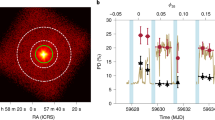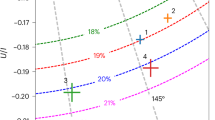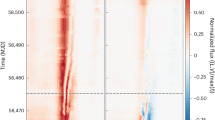Abstract
OBSERVATIONS of the pulsar PSR 0833–45 at 6 cm wavelength have shown a double structure for the pulse, a drop in the polarization from 100 per cent to 50 per cent near the pulse maximum, and a non-linear variation of polarization angle across the pulse. These observations are interpreted in terms of an oblique rotator model for the pulsar.
This is a preview of subscription content, access via your institution
Access options
Subscribe to this journal
Receive 51 print issues and online access
$199.00 per year
only $3.90 per issue
Buy this article
- Purchase on Springer Link
- Instant access to full article PDF
Prices may be subject to local taxes which are calculated during checkout
Similar content being viewed by others
References
Radhakrishnan, V., Cooke, D. J., Komesaroff, M. M., and Morris, D., Nature, 221, 443 (1969).
Radhakrishnan, V., and Cooke, D. J., Astrophys. Lett., 3, 225 (1969).
Wielebinski, R., Proc. Astron. Soc. Austral., 1, 226 (1969).
Author information
Authors and Affiliations
Rights and permissions
About this article
Cite this article
GARDNER, F., WHITEOAK, J. Linear Polarization of Pulsar PSR 0833–45 at 4.8 GHz. Nature 224, 891–893 (1969). https://doi.org/10.1038/224891d0
Received:
Issue Date:
DOI: https://doi.org/10.1038/224891d0
This article is cited by
-
Change of pulse characteristics of the Vela pulsar with frequency
Nature (1974)
-
Possible Mechanism for the Pulsar Radio Emission
Nature (1970)
Comments
By submitting a comment you agree to abide by our Terms and Community Guidelines. If you find something abusive or that does not comply with our terms or guidelines please flag it as inappropriate.



